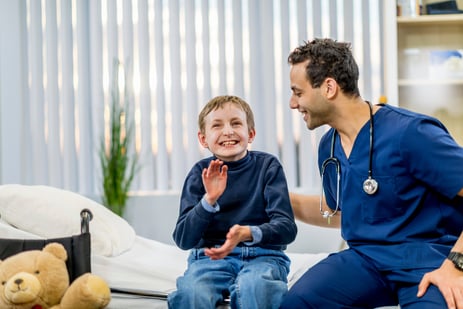Recognizing the Signs and Symptoms of Autism
Knowing What to Look for with Autism
Have you ever worried that your child is exhibiting symptoms of autism, but had no one to go to and no understanding of how to acquire a diagnosis and ensure that your child will receive the help they need?
There is no need to worry, because with all of the resources out there it is always possible to determine whether your fears are worth investigating further, and you will discover that there exists many ways to help your child.
The main difficulty that arises in the diagnosis of autism is that it may take a long time to officially diagnose the disorder. Doctors do not often make a formal diagnosis until the child is two years of age, although children as young as 6 months can begin to exhibit symptoms of autism. Often it is up to parents or guardians to observe their child’s behaviors, and notice and report any symptoms that they observe to their pediatrician. Remember that no person knows your child better than you do, and it is important that you advocate for your child at a time when it is not possible for them to advocate for themselves.
![]() It is completely normal for you to feel concerned when your child seems to be exhibiting signs of unusual or slowed development. However, by being educated about the signs and symptoms of autism and reporting any red flags you can gain control of the situation and help get an early diagnosis for your child if it is warranted. There are many incredible resources online about autism, and they provide important information on early red flags for autism as well as screening devices for parents and guardians to determine a child’s risk for autism and receive information about ways to speed the process of doctor intervention and possible treatment options.
It is completely normal for you to feel concerned when your child seems to be exhibiting signs of unusual or slowed development. However, by being educated about the signs and symptoms of autism and reporting any red flags you can gain control of the situation and help get an early diagnosis for your child if it is warranted. There are many incredible resources online about autism, and they provide important information on early red flags for autism as well as screening devices for parents and guardians to determine a child’s risk for autism and receive information about ways to speed the process of doctor intervention and possible treatment options.
Early Signs of Autism
Please note that the following are possible early markers, but they are not diagnostic. If your child has some of these characteristics you may want to ask your pediatrician for help with a diagnosis.
Symptoms exhibited between 6 months and one year:
- By 6 months: No big smiles or other warm, joyful expressions
- By 9 months: No back-and-forth sharing of sounds, smiles, or other facial expressions
- By 12 months: Lack of response to name
- By 12 months: No babbling or “baby talk”
- By 12 months: No back-and-forth gestures, such as pointing, showing, reaching, or waving
- By 16 months: No spoken words
- By 24 months: No meaningful two-word phrases that don’t involve imitating or repeating others
Symptoms exhibited between 12 and 18 months:
- The child doesn’t make eye contact (especially when being fed).
- The child does not smile back when smiled at
- The child doesn’t respond to his or her name, or respond physically to the sound of a familiar voice
- The child does not follow objects visually
- The child does not point or wave goodbye, or use other gestures to communicate
- The child doesn’t visually follow your gestures when you point out something
- The child doesn’t make noises to get parents/guardians attention
- The child does not initiate or respond to cuddling
- The child doesn’t imitate your movements and facial expressions
- The child does not reach out to be picked up
- The child doesn’t play with other people or share interest and enjoyment
- The child does not ask for help or make other basic requests
Symptoms exhibited in children over 18 months:
As your child grows older, the symptoms of autism spectrum disorder can become more diverse and specific to each child, and involve their interactions with others as well as general behaviors. However, all symptoms and warning signs revolve around the main categories of impaired social skills, speech and language difficulties, non-verbal communication difficulties including identifying and exhibiting appropriate facial and bodily movements to represent an emotion, and inflexible behavior.
Signs and symptoms of speech and language difficulties in autism
Children with autism spectrum disorders have difficulty with speech and language. Often, they have language delays.
- Speaks in an abnormal tone of voice, or with an odd rhythm or pitch (e.g. ends every sentence as if asking a question)
- Repeats the same words or phrases over and over
- Responds to a question by repeating it, rather than answering it
- Refers to themselves in the third person
- Uses language incorrectly for their age (grammatical errors, wrong words)
- Has difficulty communicating needs or desires
- Doesn’t understand simple directions, statements, or questions
- Takes what is said too literally (misses undertones of humor, irony, and sarcasm)

Signs and symptoms of nonverbal communication difficulties in autism
Children with autism spectrum disorders have trouble picking up on subtle nonverbal cues and using body language. This can make back and forth nonverbal conversation difficult and sometimes frustrating.
- Avoids eye contact
- Uses facial expressions that don't match what he or she is saying
- Does not pick up on other people’s facial expressions, tone of voice, and gestures
- Makes very few gestures (such as pointing). May come across as cold or “robot-like”
- Reacts unusually to sights, smells, textures, and sounds. May be especially sensitive to loud noises
- Uses abnormal posture, shows a lot of clumsiness, or eccentric ways of moving (e.g. walking exclusively on tiptoe)
Signs and symptoms of inflexibility in autism
Children with autism spectrum disorders are often restricted, inflexible, and even obsessive in their behaviors, activities, and interests.
- Follows a rigid routine (e.g. insists on taking a specific route to school)
- Has difficulty adapting to any changes in schedule or environment (e.g. throws a tantrum if the furniture is rearranged or bedtime is at a different time than usual)
- Shows unusual attachments to toys or strange objects such as keys, light switches, or rubber bands
- Obsessively lines things up or arranges them in a certain order
- Preoccupation with a narrow topic of interest, often involving numbers or symbols (e.g. memorizing and reciting facts about maps, train schedules, or sports statistics)
- Spends long periods of time arranging toys in specific ways, watching moving objects such as a ceiling fan, or focusing on one specific part of an object such as the wheels of a toy car
- Repeats the same actions or movements over and over again, such as flapping hands, rocking, or twirling (known as self-stimulatory behavior, or “stimming”). Some researchers and clinicians believe that these behaviors may soothe children with autism more than stimulate them.
Common self-stimulatory behaviors:
Some more visually noticeable symptoms include certain ticks that the child repeats over and over again.
|
● Hand flapping ● Rocking back and forth ● Spinning in a circle ● Finger flicking ● Head banging ● Staring at lights ● Moving fingers in front of the eyes ● Snapping fingers |
● Tapping ears ● Scratching ● Lining up toys ● Spinning objects ● Wheel spinning ● Watching moving objects ● Flicking light switches on and off ● Repeating words or noises |
Screenings that can be done at home:
There are new types of screenings that parents can use in order to identify their child’s at-risk behaviors, with test results that the child’s doctor can receive and utilize in order to achieve a quicker and more accurate diagnosis. The Modified Checklist for Autism in Toddlers, Revised with Follow-Up (M-CHAT-R/F; Robins, Fein, & Barton, 2009) is a 2-stage parent-report screening tool to assess risk for Autism Spectrum Disorder. The M-CHAT-R/F is an autism screening tool designed to identify children 16 to 30 months of age who should receive a more thorough assessment for possible early signs of autism spectrum disorder (ASD) or developmental delay. The assessment is free and identifies possible symptoms. However, it cannot be used as the only means of assessing a child, and the results must always be followed up on with your child’s pediatrician. The website where one can access this free screening is http://m-chat.org.
What can we do right now?
Diagnosis of an autism spectrum disorder may take a long time. Try not to feel discouraged, and know that there is much one can do for a child that exhibits symptoms before a formal diagnosis is made. The attachment bond is the incredibly important attachment a child forms with an adult in their life, hopefully one that they make with their parent or guardian. It is incredibly important that a child form a secure attachment with their parent/guardian. This can be especially difficult if the child shows signs of autism. Therefore, experts recommend that parents allow their children to lead the way to their own secure attachment, as autistic children can often show very specific needs that caretakers must learn to accept and fulfill, even before a formal diagnosis and treatment plan is set up.
It is important that you never feel alone in helping your child, and that you remember that there are plenty of resources (your child’s pediatrician being one of the best ones) to reach out to when you suspect that your child is exhibiting symptoms of autism.
Resources:
http://nationalautismassociation.org/resources/signs-of-autism/
https://www.autismspeaks.org/what-autism/learn-signs
http://www.helpguide.org/articles/autism/autism-symptoms-and-early-signs.htm
http://blog.stageslearning.com/blog/topic/about-autism
Helpful Screening Site to be used in conjunction with a doctor or specialist:
If you are interested in more information about autism and tools to help children with autism please sign up below for our newsletter:

Michelle Kuras
Michelle Kuras is a sophomore at Lesley University studying Counseling Psychology. She has experience working one on one with a child suffering from high-functioning autism, and has a passion for learning about the experiences of others and using that information to gain perspective in order to help the people she encounters. She hopes to work as a school counselor for young children in the future, specializing in early intervention for cases of anxiety and depression. She loves to help people and children of all different needs. She can be contacted with any questions at mkuras@lesley.edu.




